
Alaska is a U.S. state on the northwest extremity of North America. A semi-exclave of the U.S., it borders British Columbia and Yukon in Canada to the east, and it shares a western maritime border in the Bering Strait with the Russian Federation's Chukotka Autonomous Okrug. To the north are the Chukchi and Beaufort Seas of the Arctic Ocean, and the Pacific Ocean lies to the south and southwest.

Seward is an incorporated home rule city in Alaska, United States. Located on Resurrection Bay, a fjord of the Gulf of Alaska on the Kenai Peninsula, Seward is situated on Alaska's southern coast, approximately 120 miles (190 km) by road from Alaska's largest city, Anchorage.
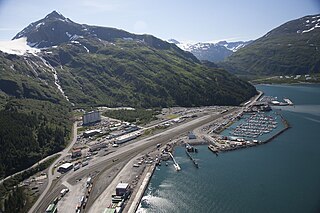
Whittier is a city at the head of the Passage Canal in the U.S. state of Alaska, about 58 miles (93 km) southeast of Anchorage. The city is within the Chugach Census Area, one of the two entities established in 2019 when the former Valdez–Cordova Census Area was dissolved. It is also a port for the Alaska Marine Highway. The population was 272 at the 2020 census, having increased from 220 in 2010. The city is notable for the fact that almost all of its residents live in the Begich Towers Condominium, earning it the nickname of a "town under one roof".

The 1964 Alaskan earthquake, also known as the Great Alaskan earthquake and Good Friday earthquake, occurred at 5:36 PM AKST on Good Friday, March 27. Across south-central Alaska, ground fissures, collapsing structures, and tsunamis resulting from the earthquake caused about 131 deaths.

Cook Inlet stretches 180 miles (290 km) from the Gulf of Alaska to Anchorage in south-central Alaska. Cook Inlet branches into the Knik Arm and Turnagain Arm at its northern end, almost surrounding Anchorage. On its southern end, it merges with Shelikof Strait, Stevenson Entrance, Kennedy Entrance and Chugach Passage.

The Port of Alaska (POA) is a deep-water port located in Anchorage, Alaska with 3 bulk carrier berths, two petroleum berths, and one barge berth. It is an enterprise department of the Municipality of Anchorage. The name was changed from "Port of Anchorage" to the "Port of Alaska" in 2017. As such, the Port is distinguished from other types of municipal departments largely because it generates enough revenue to support its operations without being a burden to Anchorage property tax payers, and it also pays a fee-in-lieu of taxes to help run city government.
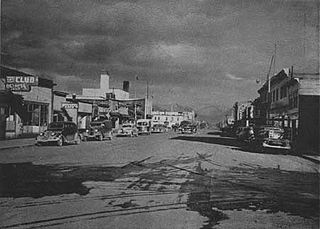
After congress approved the completion of the Alaska Railroad from Seward to Fairbanks in 1914, it was decided that a new town should be built as a port and rail hub along the route. The decision was made to develop a site near Ship Creek on Cook Inlet. Survey parties visited the area in 1914 and researched possible routes for the rails and options for siting the new town. Anchorage was originally settled as a tent city near the mouth of Ship Creek in 1915, and a planned townsite was platted alongside the bluff to the south. Anchorage was mostly a company town for the Alaska Railroad for its first several decades of existence.

The Municipality of Anchorage is the largest city in the U.S. state of Alaska by population. With a population of 291,247 at the 2020 census, it contains nearly 40% of the state's population. The Anchorage metropolitan area, which includes Anchorage and the neighboring Matanuska-Susitna Borough, had a population of 398,328 in 2020, accounting for more than half the state's population. At 1,706 sq mi (4,420 km2) of land area, the city is the fourth-largest by area in the United States and larger than the smallest state, Rhode Island, which has 1,212 sq mi (3,140 km2).
The Jesse Lee Home for Children was a former home for displaced children on Swetmann Avenue in Seward, Alaska, United States. It was operated by the United Methodist Church from its opening in 1926 until the building suffered damage from a 1964 earthquake and operations were relocated to a new building in Anchorage.
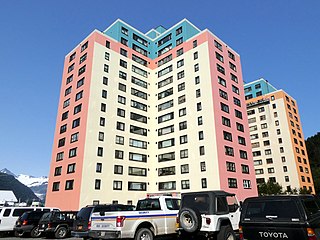
The Begich Towers Condominium is a building in the small city of Whittier, Alaska. The structure is notable for being the residence for nearly the entire population of the city as well as containing many of its public facilities. This has earned Whittier the nickname of a "town under one roof".

Portage is a ghost town and former settlement on Turnagain Arm in Alaska, about 47 miles (76 km) southeast of Downtown Anchorage. The town was destroyed in the 1964 Alaska earthquake when the ground in the area sank about six feet (1.8 m), putting most of the town below high tide level. All that remains today are the ruins of a few buildings and a "ghost forest" of trees that died after salt water inundated their root systems. Where there was once a town there is now only a railroad and road junction linking the Seward Highway and the Alaska Railroad to Portage Glacier park and the Anton Anderson Memorial Tunnel, which leads to Whittier.
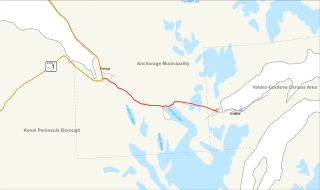
The Portage Glacier Highway, or Portage Glacier Road, is a highway located in the U.S. state of Alaska. The highway is made up of a series of roads, bridges, and tunnels that connect the Portage Glacier area of the Chugach National Forest and the city of Whittier to the Seward Highway. Most of the highway travels through mainly rural areas just north of the Kenai Peninsula, with the Anton Anderson Memorial Tunnel passing under Maynard Mountain, part of the Chugach Mountain Range. Parts of the route were first constructed in the early 1900s, and the entire highway was completed on June 7, 2000, as part of the Whittier Access Project. The main portion of the highway traveling from the western terminus to the Begich, Boggs Visitor Center at Portage Lake is designated as National Forest Highway 35 by the United States Forest Service (USFS).
Camp Sullivan was a United States Army camp located in Whittier, Alaska from 1943 to 1960. Constructed out of a need to supply the region with military support during World War II, the area became important again during the Cold War after the Army decided to build the 14-story Hodge Building completed in 1957 contained 150 two and three bedroom apartments plus bachelor efficiency units. Dependent families and Civil Service employees were moved into this efficient high rise. The new Whittier School was connected by a tunnel at the base of the west tower so students could go to school in short sleeves on the very worst weather days. The building, originally was named in honor of Colonel Walter William Hodge Civil. Engineer. the CO of 93rd Engineer Regiment on the Alcan Highway. The other structure, the Buckner Building, had been completed in 1953, and was called the "city under one roof". Both buildings were at one time the largest buildings in Alaska. The Begich Building is now a condominium. Together with the 2-story Whittier Manor, Begich Building houses nearly all of Whittier's residents. The port remained an active Army facility until 1960.
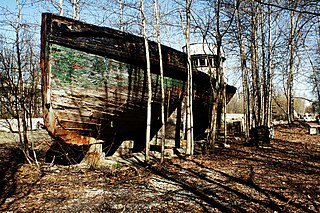
Chacon was a 72 ft (22 m) dry docked wooden vessel and roadside curiosity in Chugiak, Alaska, United States. The former cannery tender occupied a parcel at 17049 Old Glenn Highway until March 11, 2022, and served as a memorial to her former owner, Thillman Wallace of Chugiak (1932–2015).

Harold B. Foss (1910-1988) was an American architect from Juneau, Alaska.

On November 30, 2018, at 8:29 a.m. AKST (17:29 UTC), a magnitude 7.1 earthquake hit Anchorage in South Central Alaska. The earthquake's epicenter was near Point Mackenzie, about 10 miles (16 km) north of Anchorage, and occurred at a depth of 29 miles (47 km). It was followed six minutes later by a magnitude 5.7 aftershock centered 2.5 miles (4.0 km) north-northwest of the municipality. The earthquake could be felt as far away as Fairbanks.
Lidia Lippi Selkregg was an Italian geologist and professor of regional planning at the University of Alaska Anchorage. In the days following the 1964 Alaska earthquake, Selkregg helped organize a group of local geologists to gather important data about earthquake damage to inform future recommendations about building stability. She also helped promote earthquake safety, land preservation, and economic development in the Anchorage area.
The 1958 Huslia earthquake on April 7 struck an unusual part of Alaska, near the city of Huslia, about 415 km from Fairbanks. The Ms 7.3 earthquake is one of two magnitude 7.0 or greater earthquakes recorded north of 65° latitude, the other being the 1933 Baffin Bay earthquake, and is one of the strongest earthquakes within the interior of the state. The earthquake was a result of compression of the crust due to the subduction of the Pacific Plate under the North American Plate.
















